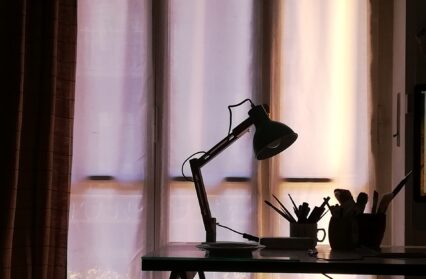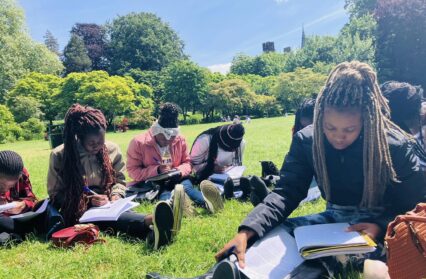Sarah Featherstone reflects on her creative journey, from arriving in Cardiff in the nineties as a student nurse, to becoming an art facilitator with all the highs and lows of freelance life.
I walk from the halls of residence at the Heath hospital to the Student Union on Park Place in my new purple DMs. It’s 1992, and I’m going to meet members of Cardiff university’s Pagan Society, or CUPS, a group that is to become an important source of support during my Undergrad years as a student nurse. At various seasonal points throughout the term, the uni van swings by the hospital to pick me up, the door sliding open to admit me into a world of tye-dye, tarot cards, incense and crystals, a colourful mix of people seeking alternative narratives, bonded by a love of nature. We dance around fires on the beach at Ogmore, or in the quarry near Castell Coch, offering libations to pre-Christian Goddesses and Gods in their many forms. It feels liberating and subversive, the perfect antidote to the sterility of the hospital wards. I become known as ‘Mystic Rosie’ amongst my fellow nursing students, arriving back at the halls smelling of woodsmoke as they emerge from Med Club still swaying to Come on Eileen with the medics.
When I graduate, the reality of life on the wards with too much responsibility and too little support is tough. I cope, because outside I remain embedded in the Cardiff magical community. CUPS splinters off into smaller groups meeting at regular intervals to celebrate the sabbats, meditate on the moon’s cycles, and share knowledge about things like divination techniques and the symbolism of herbs. Eventually, a chance meeting at a workshop on Atlantis leads me to Ceredigion to live in an old stone house with a memorial plague in the garden commemorating the formation of Yr Urdd Gobaith Cymru in 1922. Inside, is a blacked-out temple room with a huge round table, the twelve signs of the zodiac painted on it by the Pagan priest I share the house with. By day, I’m a district nurse driving miles to remote farms to attend to leg ulcers, and by night we perform rituals in the temple and the woods. Surrounded by animals, close to the sea, it should be perfect, but it soon becomes clear that the priest and I have different expectations. And though I love the rich experiences being a nurse gives me, I’m becoming burnt out by the pressure to see more and more patients in a day.
I get a job in the third sector with Woman’s Aid, taking the children on trips and supporting women to start a new life. In the evenings I go to poetry classes in Lampeter run by Gillian Clarke and write some poems that get me a place on an MA in Creative Writing in Bath. I rent a one-bedroom flat with my new partner next to a house with a blue plague on the wall announcing that Jane Austen lived there with her family from 1801-1804. It seems like a good omen. Then, in the second year of the MA, I find out I’m pregnant.
My partner at that time is from Newport, so we buy an ex-council house on the Maesglas estate, where the baby is born. On the side of the Maesglas shops is a mural with the words of Newport-born writer Leslie Thomas in a painting of an open book:
Maesglas was a penniless place everybody called Moscow. When it was built in the thirties the winter was of such Soviet severity that the frost-bound workmen gave it the name. Poor though it was, nobody who ever lived there can today mention its name or its Russian nickname without breaking into a grin.
I wish I could fully appreciate the community in Maesglas, but I feel like I’m suffocating in my new domestic roles as mother and fiancé. As artist Lizzie Philps writes, there is nothing like pushing a buggy to bring home the dreaded complicity of being “just” a mum. “Words like natural and instinct become silencing devices to those who ask why everything has changed. Suddenly there is a lot to get cross about.”
I go out at night after my son’s father gets home and walk for miles around Newport in a daze, tears streaming down my face. Consumed by postnatal depression and sleep deprivation, I’ve lost sight of myself. I’m convinced that if I only had ‘a room of my own’ such as Virginia Woolf wrote about, everything will be ok. I crave the woods and beaches of Ceredigion, the cultural life of Bath. Where has it all gone wrong? The only creative work I do in those early years after my son’s birth is to write in my journal, recording the quotidian routine of nappies, breastfeeding, food-making, washing, and the limited interactions in between. It feels like my world has shrunk to the view through the window.
Eventually, I move to a flat on Stow Hill, and though I now have a room of my own, I don’t use it. Maybe it’s only in retrospect that we find out what we really need. I meet people, I go out, filling the empty space when my son is with his dad, living as I would have done as a teenager if I’d had the chance. It’s a vulnerable place to be – trying to bring up a child with no roots, catching up with myself emotionally, always on the edge of falling apart. Although Newport is the right place to be for my creative self, it holds up a stark mirror to my shaky identity and cultural naivety.
At this time, an Arts Council funded venture called The Empty Shops Project gives artists a free space for a limited period to show their work and interact with the public. It’s wonderfully anti-capitalist, a crucible for bringing people together through art. I join a couple of art collectives and take part in some of the exhibitions and ‘happenings’ of Newport’s vibrant underground scene. As with the Pagan community, it gives me the courage to be who I want to be outside of all the social expectations. Eventually, I make the transition into freelance work as an artist and writer. I combine my healthcare background with my creative skills to facilitate Creative Wellbeing groups in many community settings. Another crossroads, another choice: play it safe and remain watching shadows like the people in Plato’s cave, or step into the unknown and grow and change.
Being a creative freelancer is wonderful and terrifying in equal measure. It’s so empowering to collaborate on projects, sometimes without a clue how you’re going to produce the desired outcome, simply trusting the creative process. Somehow, when you put yourself out there, the muse always seems to come through.
I manage to get some temporary teaching work in between projects, but as I only get paid during term time, the holidays gape like a wolf’s maw. I wake in the middle of the night, heart banging as I try to work out how I’m going to keep everything afloat. Sometimes I get up and start searching for projects to apply for, filling in yet another application form.
Choreographer/Performer and fellow psychotherapy student, Zosia Jo writes: “In order to be artists, we must be free. But what is freedom? To me freedom is time to rest, time to research. These things are not built into our systems. We need a greener system. One that allows the land, and ourselves, time to rejuvenate in between harvests.” She talks about ‘leaning in’ – to softness, fluidity and slow power, the relationship of personal and ecological sustainability and the concept of radical rest. ‘We live with the perception of, or reality of, scarcity. It pits us against each other and, desperate to prove our worth we work ourselves raw. Our current system expects us to explain what the outcome – what the product- of a project will be before we even begin’.
There won’t be any radical rest for me for a while. Embarking on psychotherapy training seems like a viable route to bringing everything together into a more sustainable whole, but it’s going to be a long haul. It takes six years before I’II be a qualified therapist. In the meantime, I get to delve deeper into the archetypal landscape of the collective unconscious: not a bad place for an artist to be.











